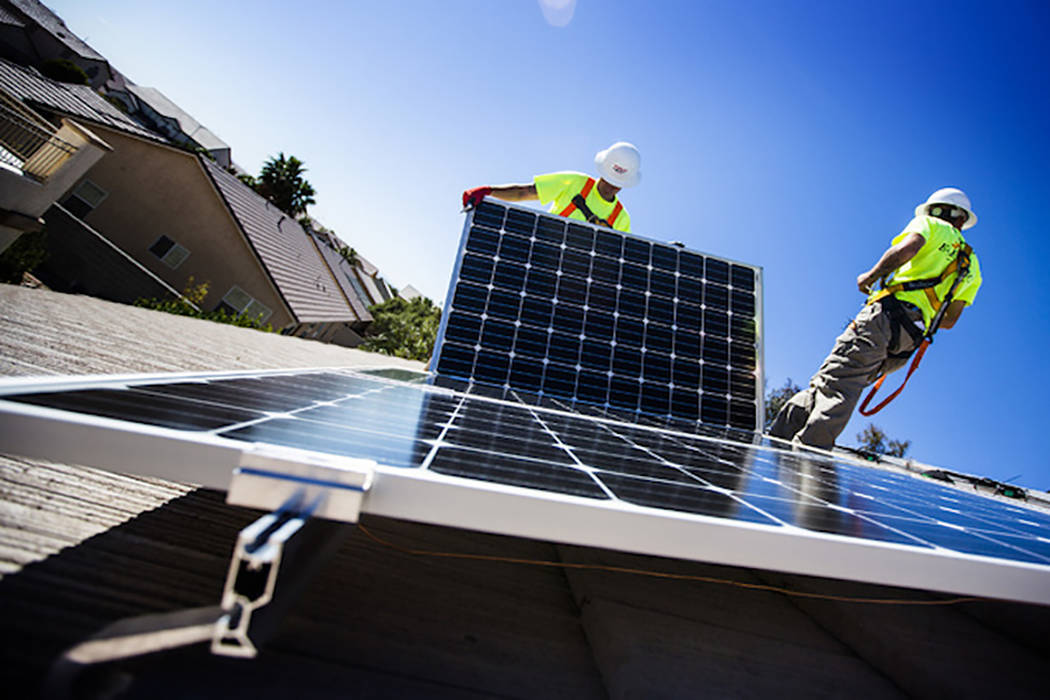Valley Electric’s board considers changes to net metering policy
Valley Electric Association Inc.’s board of directors is set to mull over potential changes to the co-op’s current net metering policy.
The new policy, set to be taken up at Valley’s June 26 board meeting, would lower the current rate of 100 percent, or 11.9 cents per kilowatt-hour, to a tiered system where those with solar would get 75-95 percent of the current rate, “depending on when the member-generator interconnected with the VEA grid,” according to a news release from Valley.
That comes out to 9 cents a kilowatt hour under the 75 percent bracket, according to Interim Chief Executive of Valley Electric Association Inc. Dick Peck.
According to the co-op, the new policy would mirror Assembly Bill 405 on net metering, which was signed into law in 2017 by then-Gov. Brian Sandoval. Net metering is where those with rooftop solar get a credit for the excess energy they return to the grid.
Valley is exempt from the law but offers the program to local customers wanting to install solar, according to a news release from the co-op.
The co-op currently offers 100 percent, or 11.9 cents per kilowatt-hour for the excess energy it sends back to the grid.
Tiered system
Under the proposed net metering policy, VEA policy No. 136, members of Valley installing solar will follow a tiered system, which will be “tied to the date that a completed application to install a net-metering system was received,” according to Valley’s news release.
According to Valley, the first solar generator interconnected to the co-op in 2006 and has grown into the hundreds since that time.
Overall, the system is set that the earlier an application was put in, the higher the reimbursement rate.
For Tier One, where members who interconnected with Valley prior to the generation amount exceeded 1.25 megawatts, those members will receive 95 percent of the full retail rate of 11.9 cents per kilowatt hour. The 1.25 megawatt threshold was crossed in 2015, according to Valley’s release.
Tier Two includes those members that brought the generation from 1.25 to 2.5 megawatts, which occurred in 2017. Under that tier, members will be paid 88 percent of the full retail rate.
Tier Three will be paid 81 percent of the full retail rate for excess energy. This group brought the generated amount from “2.5-3.75 megawatts” in 2019.
Members falling under Tier Four will be reimbursed 75 percent of Valley’s full retail rate.
“The majority of VEA’s generation of renewable energy by members comes in the form of solar, but some members generate power with wind turbines,” Valley’s release stated. “Since the total number of applications in house would bring the system size to nearly 6 megawatts, virtually all new applications would be reimbursed at 75% of the retail rate.”
“With these revisions, Valley Electric will be in line with state law, which serves to encourage the development of solar generation,” Peck said in a news release. “The wholesale power rate is approximately 4 cents per kilowatt-hour, but we had been paying our member-generators 11.9 cents for their excess power. We have to always remember that members who do not generate renewable energy are subsidizing those who do.”
According to Peck, the number of member-generators has grown significantly in the past couple years, which is prompting the need for revisions to the co-op’s policy.
In a news release, Peck estimated that Valley paid $230,000 for power under its net metering program in 2018.
Valley currently has over 600 generators that participate in Valley’s net metering program, equating to approximately 3 percent of the membership, according to Valley’s release.
The number of generators did not pass 100 until 2014, according to Valley’s release.
The topic will be taken up at Valley’s next board meeting at the co-op’s administrative offices in Pahrump. The meeting is scheduled to begin at 8:30 a.m. at 800 E. Highway 372.
Watch for upcoming coverage on this topic on pvtimes.com or in the Pahrump Valley Times’ print edition.
Contact reporter Jeffrey Meehan at jmeehan@pvtimes.com. On Twitter: @pvtimes


















